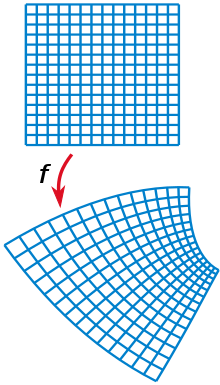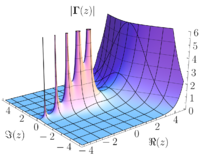
Back إسقاط تشكيلي Arabic Transformació conforme Catalan Konformní zobrazení Czech Konforme Abbildung German Konforma bildigo Esperanto Transformación conforme Spanish نگاشت همدیس Persian Konformikuvaus Finnish Transformation conforme French העתקה קונפורמית HE

| Mathematical analysis → Complex analysis |
| Complex analysis |
|---|
 |
| Complex numbers |
| Complex functions |
| Basic theory |
| Geometric function theory |
| People |
In mathematics, a conformal map is a function that locally preserves angles, but not necessarily lengths.
More formally, let and be open subsets of . A function is called conformal (or angle-preserving) at a point if it preserves angles between directed curves through , as well as preserving orientation. Conformal maps preserve both angles and the shapes of infinitesimally small figures, but not necessarily their size or curvature.
The conformal property may be described in terms of the Jacobian derivative matrix of a coordinate transformation. The transformation is conformal whenever the Jacobian at each point is a positive scalar times a rotation matrix (orthogonal with determinant one). Some authors define conformality to include orientation-reversing mappings whose Jacobians can be written as any scalar times any orthogonal matrix.[1]
For mappings in two dimensions, the (orientation-preserving) conformal mappings are precisely the locally invertible complex analytic functions. In three and higher dimensions, Liouville's theorem sharply limits the conformal mappings to a few types.
The notion of conformality generalizes in a natural way to maps between Riemannian or semi-Riemannian manifolds.
- ^ Blair, David (2000-08-17). Inversion Theory and Conformal Mapping. The Student Mathematical Library. Vol. 9. Providence, Rhode Island: American Mathematical Society. doi:10.1090/stml/009. ISBN 978-0-8218-2636-2. S2CID 118752074.






